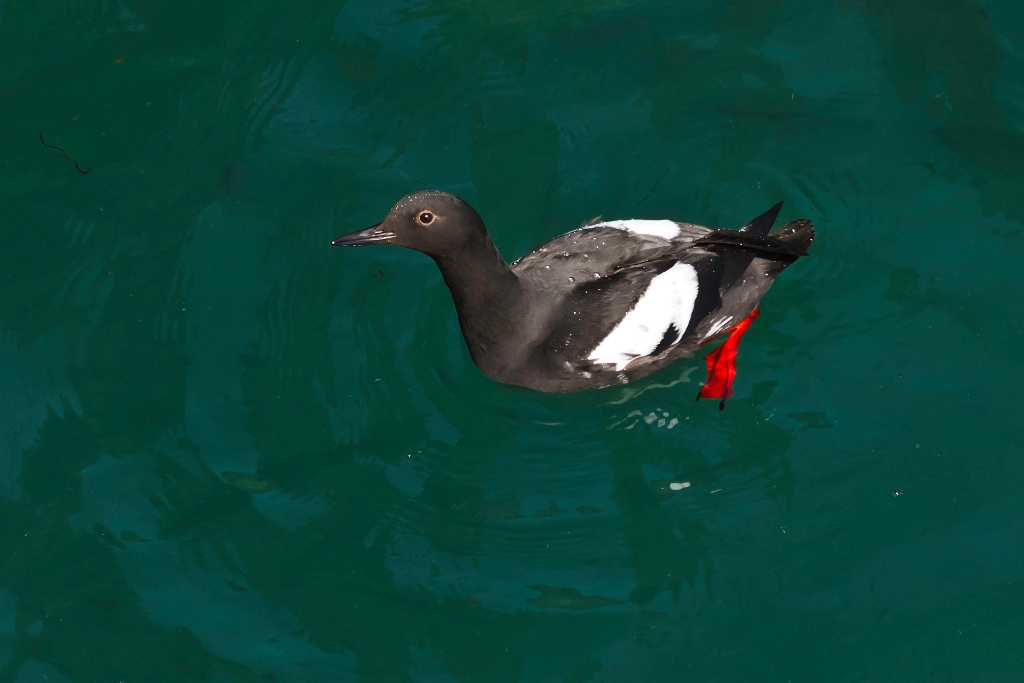
Scientific Name
Cepphus columba
Introduction
The pigeon guillemot is a North Pacific seabird belonging to the auk family which includes guillemots, puffins, auklets, and murrelets. The Channel Islands National Park, owing to its isolation and protected environment, provides ideal habitat for the pigeon guillemot breeding colonies. The park's generally abundant food sources are ideally suited for a bird who dives directly to the sea bed, probing rocky recesses and vegetation with their bills for fish and invertebrates. This bird is found along rocky shores in small colonies or isolated pairs. The pigeon guillemot nests in burrows or under rocks, often on small islands that provide protection from predators.
Quick and Cool Facts
- Pigeon guillemots have an extensive breeding range along the western North America coast from Alaska to California.
- This seabird can scale vertical rock faces by flapping its wings and using its sharp claws.
- Pigeon guillemots dive into the water to feed on fish and invertebrates.
- The usually lay their eggs in rocky crevices and cavities along cliffs.
- Pigeon guillemots will lay one to two eggs.
- They usually return to their natal colony to breed.
- Both parents incubate a single egg.
Appearance
The pigeon guillemots are stocky birds with rounded wings and bodies, and straight bills. In breeding plumage, adults are solid black with white wing patches. The bird's striking red-orange legs and mouth lining play a role in courtship during breeding season. Non-breeding adults and juveniles have white bellies and are mottled gray-and-white above. In all plumages, the birds have bright red feet.
Range
Pigeon guillemots are distributed in subtidal and intertidal marine habitats and on rocky shores from the Russian Pacific coast, to Alaska and down through California. The widest distribution, (as shown on the map), is in the northwestern part of the North American continent. Santa Barbara Island is at the southern edge of their range. Adults are present from February to late August on the Channel Islands.
Habitat
The pigeon guillemot needs rocky, undisturbed shoreline for nesting, and access to nearby marine waters for feeding. It feeds in shallower waters than most auks, puffins, or murrelets. Although it is known to dive to depths of greater than 150 feet, it feeds best in waters of only 35 to 65 feet in depth.The pigeon guillemot, when not feeding, often rests on sea cliff ledges, or on the surface of coastal waters. By vigorous flapping of its wings combined with the use of its sharp claws on its webbed feet, it often scales vertical rock faces.
Feeding
During the breeding season, the pigeon guillemot subsists largely on small fish. It pursues and captures fish in water near coast or island shores. Besides fish, it is also reported to eat small crabs and shrimp as well as mollusks, crustaceans, and polychaete worms. It is reported that parents bring young an average of 16 food loads a day, typically bringing a single fish each time.
Reproduction
Pigeon guillemots nests in cliff crevices and talus slopes, or occasionally in burrows. They also use human-made structures such as pipes, culverts, or crevices in wharves. Eggs are laid within these crevices on bare soil or rock, or sometimes on a loose bed of shells and pebbles. The guillemot is monogamous. It generally forms loose colonies with a few pairs dispersed over suitable nesting habitat, but occasionally a pair will nest solitarily. Clutches usually contain two eggs with an incubation period of 30-32 days. Parents share incubation duties by trading off every 1-2 hours. Nestlings are semiprecocial and downy; nestling period lasts 35-45 days. Fledglings leave the nest at about 90% adult weight. On the Channel Islands, they lay eggs from mid-April through mid-June, with a peak in early May. Chicks hatch from mid-May through mid-July, with a peak in early June. Young fledge from late June through late August, with a peak in mid-July.
Migration
Winter range of California's breeding population is unknown. However, individuals banded on the Farallon Islands have been recovered mostly in the north, as far as British Columbia, which suggests a northward movement.
Conservation Status
They readily abandon their nest if disturbed during incubation or brooding. Because they spend much time on inshore waters where oil exploration and development are centered, they are vulnerable to oil pollution. Historically, warm ocean temperatures have produced dramatic nesting failures, such as during the 1983 breeding season. The global population of this bird is estimated to be around 470,000 individual birds. It is believed unlikely that the population trends for this species will soon approach the minimum levels that could suggest a potential decline in population. Therefore, population trends for the pigeon guillemot have a present evaluation level of Least Concern.
Additional Information
Is there something we missed for this itinerary?
Itineraries across USA


















































